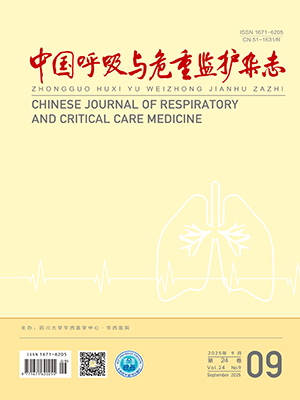| 1. |
Wenzel SE. Asthma: defining of the persistent adult phenotypes.Lancet, 2006, 368: 804-813 .
|
| 2. |
Henderson J, Granell R, Sterne J. The search for new asthma phenotypes. Arch Dis Child, 2009, 94: 333-336 .
|
| 3. |
Global Initiative for Asthma. Global Strategy for Asthma Management and Prevention 2009 ( update) .
|
| 4. |
Martinez FD. Development of wheezing disorders and asthma in preschool children. Pediatrics, 2002 , 109: 362-367 .
|
| 5. |
Taussig LM, Wright AL, Holberg CJ, et al. Tucson Children’s Respiratory Study: 1980 to present. J Allergy Clin Immunol, 2003 ,111 : 661-675.
|
| 6. |
De Marco R, Locatelli F, Cerveri I, et al. Incidence and remission of asthma: a retrospective study on the natural history of asthma in Italy. J Allergy Clin Immunol, 2002, 110: 228-235.
|
| 7. |
Bel EH. Clinical phenotypes of asthma. Curr Opin PulmMed, 2004 ,10: 44-50 .
|
| 8. |
Wardlaw AJ, Silverman M, Siva R, et al. Multi-dimensional phenotyping: towards a new taxonomy for airway disease. Clin Exp Allergy, 2005, 35 : 1254 -1262 .
|
| 9. |
Haldar P, Pavord ID, Shaw DE, et al. Cluster analysis and clinical asthma phenotypes. Am J Respir Crit Care Med, 2008 , 178 : 218 -224 .
|
| 10. |
Moore WC, Meyers DA, Wenzel SE, et al. Identification of asthma phenotypes using cluster analysis in the Severe Asthma Research Program. Am J Respir Crit Care Med, 2010, 181: 315 -323.
|
| 11. |
Fahy JV. Identifying clinical phenotypes of asthma: steps in the right direction. Am J Respir Crit Care Med, 2010 , 181: 296-297.
|
| 12. |
Strek ME. Difficult asthma. Proc Am Thorac Soc , 2006 , 3: 116-123 .
|
| 13. |
Proceedings of the ATS workshop on refractory asthma: current understanding, recommendations, and unanswered questions. Am J Respir Crit Care Med, 2000 , 162: 2341-2351.
|
| 14. |
Alves Rde S, Vianna Fde A, Pereira CA. Clinical phenotypes of severe asthma. J Bras Pneumol, 2008, 34: 646 -653.
|
| 15. |
Miranda C, Busacker A, Balzar S, et al. Distinguishing severe asthma phenotypes: role of age at onset and eosinophillic inflammation. J Allergy Clin Immunol, 2004, 113: 101-108 .
|
| 16. |
Gibson PG. Inflammatory phenotypes in adult asthma: clinical applications. Clin Respir J, 2009, 3: 198-206 .
|
| 17. |
Pavord ID, Shaw DE, Gibson PG, et al. Inflammometry to assess airway diseases. Lancet, 2008, 372 : 1017-1019.
|
| 18. |
Simpson JL, Scott R, Boyle MJ, et al. Inflammatory subtypes in asthma: assessment and identification using induced sputum.Respirology, 2006, 11: 54 -61 .
|
| 19. |
Nadif R, Siroux V, Oryszczyn MP. et al. Heterogeneity of asthma according to blood inflammatory patterns. Thorax, 2009, 64: 374 -380.
|
| 20. |
Meijer RJ, Postma DS, Kauffman HF, et al. Accuracy of eosinophils and eosinophil cationic protein to predict steroid improvement in asthma. Clin Exp Allergy, 2002, 32 : 1096-1103. 21 Woodruff PG, Modrek B, Choy DF, et al. T-helper type 2 -driven inflammationdefines major subphenotypes of asthma. Am J Respir Crit Care Med, 2009, 180: 388-395.
|
| 21. |
Gibson PG, Simpson JL, Saltos N. Heterogeneity of airway inflammation in persistent asthma: evidence of neutrophilic inflammation and increased sputum interleukin-8. Chest, 2001, 119 :1329-1336.
|
| 22. |
Simpson JL, Grissell TV, Douwes J, et al. Innate immune activation in neutrophilic asthma and bronchiectasis. Thorax, 2007,62:211-218.
|
| 23. |
ML Fajt, SE Wenzel. Asthma phenotypes in adults and clinical implications. Expert Rev Resp Med, 2009, 3: 607 -625.
|
| 24. |
Haldar P, Pavord ID. Noneosinophilic asthma: a distinct clinical and pathologic phenotype. J Allergy Clin Immunol, 2007, 119: 1043 -1052.
|
| 25. |
Parameswaran K, Leigh R, Hargreave FE. Sputum eosinophil count to assess compliance with corticosteroid therapy in asthma. J Allergy Clin Immunol, 1999, 104: 502 -503.
|
| 26. |
Green R, Brightling CE, McKenna S, et al. Asthma exacerbations and sputum eosinophil counts: a randomised controlled trial.Lancet, 2002, 360 : 1715 -1721 .
|
| 27. |
Jayaram L, Pizzichini MM, Cook RJ, et al. Determining asthma treatment by monitoring sputum cell counts: effect on exacerbations. Eur Respir J, 2006, 27 : 483 -494.
|
| 28. |
曹文利, 孙永昌, 姚婉贞. 根据支气管哮喘患者痰嗜酸粒细胞计数调整糖皮质激素剂量的临床意义. 中华结核和呼吸杂志,2009, 30: 334-338 .
|
| 29. |
Haldar P, Brightling CE, Hargadon B, et al. Mepolizumab and exacerbations of refractory eosinophilic asthma. N Engl J Med,2009, 360: 973-984.
|
| 30. |
Nair P, Pizzichini MM, Kjarsgaard M, et al. Mepolizumab for prednisone-dependent asthma with sputum eosinophilia. N Engl J Med, 2009, 360: 985-993.
|
| 31. |
Leckie MJ, ten Brinke A, Khan J, et al. Effects of an interleukin-5 blocking monoclonal antibody on eosinophils, airway hyperresponsiveness, and the late asthmatic response. Lancet, 2000, 356 :2144-2148.
|
| 32. |
Flood-Page P, Swenson C, Faiferman I, et al. A study to evaluate safety and efficacy of mepolizumab in patients with moderate persistent asthma. Am J Respir Crit Care Med, 2007 , 176: 1062 -1071.
|




